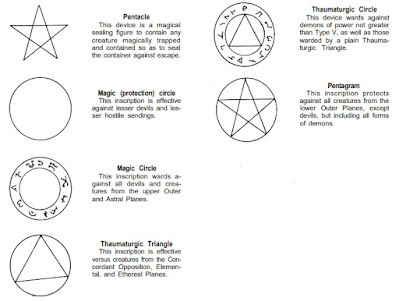The Articles of Dragon: "Protection Circles and the Like ..."
 One of the ways that this new version of The Articles of Dragon differs from its predecessor is that I'll linger on a single issue of the magazine if there's more than one article I consider worthy of comment. Perhaps because issue #56 (December 1981) is the first one I remember reading, I can also recall multiple articles from its pages. In addition to "Singing a New Tune," which I discussed last week, another that left a lasting impression on me was Gary Gygax's "From the Sorcerer's Scroll" column, entitled "Protection Circles and the Like, plus News of the North Central Flanaess" – quite a mouthful!
One of the ways that this new version of The Articles of Dragon differs from its predecessor is that I'll linger on a single issue of the magazine if there's more than one article I consider worthy of comment. Perhaps because issue #56 (December 1981) is the first one I remember reading, I can also recall multiple articles from its pages. In addition to "Singing a New Tune," which I discussed last week, another that left a lasting impression on me was Gary Gygax's "From the Sorcerer's Scroll" column, entitled "Protection Circles and the Like, plus News of the North Central Flanaess" – quite a mouthful!
The article begins, as its title suggests, by briefly touching on the six types of protective circles available to AD&D spellcasters. These circles consist of the pentacle, magic (protection) circle, magic circle, thaumaturgic triangle, thaumaturgic circle, and the pentagram. Each one is accompanied by an illustration and a very brief description of its purpose (e.g. "This inscription is effective against lesser devils and lesser hostile sendings."). There are, however, no game mechanics associated with any of these circles. Gygax indicates such information will appear in the forthcoming The Lost Caverns of Tsojcanth module (which would appear sometime the following year, 1982).
Though this section of the column was very small and devoid of much in the way of specifics, it nevertheless left a strong impression on me, probably because of the accompanying artwork, which expanded upon what can be found on page 42 on the Dungeon Masters Guide.
 Over the years, Gygax was inconsistent on the matter of just how much (A)D&D drew on real world occultism for inspiration (depending, no doubt, on who was inquiring about it). My friends and I, however, had no doubt that the game frequently took pages from such things – that was part of its appeal! So, even though there's not much meat to this part of "From the Sorcerer's Scroll," it's stuck with me even after all these years.
Over the years, Gygax was inconsistent on the matter of just how much (A)D&D drew on real world occultism for inspiration (depending, no doubt, on who was inquiring about it). My friends and I, however, had no doubt that the game frequently took pages from such things – that was part of its appeal! So, even though there's not much meat to this part of "From the Sorcerer's Scroll," it's stuck with me even after all these years.That said, the next part, which is quite substantial, stuck with me even more. In it, Gygax presents news and updated information about The World of Greyhawk, specifically about events following the return of the half-demon demigod Iuz to the domain that bears his name in the aftermath of his long imprisonment within Castle Greyhawk. Now, at the time I read this, I didn't yet own a copy of The World of Greyhawk, though I was vaguely familiar with some of the names and places associated with it through other AD&D products, like the DMG and The Village of Hommlet. Despite this, I found this section strangely compelling.
A big part of it, I think, was that it implied that Greyhawk was a dynamic setting in which Things Happened and had an impact on the setting. In addition, Gygax rattled off the names of important NPCs within the setting, along with their races, classes, and levels. He tallied up military units and their strengths and locations. He mentioned battles and geographic features. In short, he made Greyhawk come alive, as if it had a real (and deep) history. I loved it and wanted to learn more.
Of course, that's not what's included in The World of Greyhawk at all. The original folio – and even the later boxed set – were short on these kinds of nitty-gritty details, focusing instead on Big Picture stuff. I learned to appreciate that as one of Greyhawk's greatest virtues as a setting, but what initially drew me to it was this article and all the stuff Gygax implied was happening in his own campaign. In retrospect, I suspect that's exactly what Gygax was doing: recounting how his campaign was unfolding, but I had no real understanding of such a distinction in 1981 and wouldn't for many more years. Regardless, I loved this article.
James Maliszewski's Blog
- James Maliszewski's profile
- 3 followers



